As world leaders prepare to descend on Dubai ahead of the approaching United Nations climate talks – COP28 – the globe is acutely aware of two facts: the planet is accelerating toward climate disaster, and governments are acting too slowly to avert the impending crisis. Trinidad and Tobago is no exception, with the country’s government repeatedly doubling down on its commitment to producing hydrocarbons, which emit greenhouse gases when burned, as long as the world needs it.
The United Nations, in mid-November, released its Nationally Determined Contributions Synthesis report, noting that despite the toll of global warming and human-induced climate change.
“Governments combined are taking baby steps to avert the climate crisis,” said Executive-Secretary of UN Climate Change, Simon Stiell.
Based on the latest science from the UN’s Intergovernmental Panel on Climate Change (IPCC), the primary step is to cut greenhouse gas emissions by 43% by 2030, compared to 2019. This reduction is critical to limiting the temperature rise to 1.5 degrees Celsius by the end of this century and avoiding the worst impacts of climate change, including more frequent and severe droughts, heat waves, and rainfall.
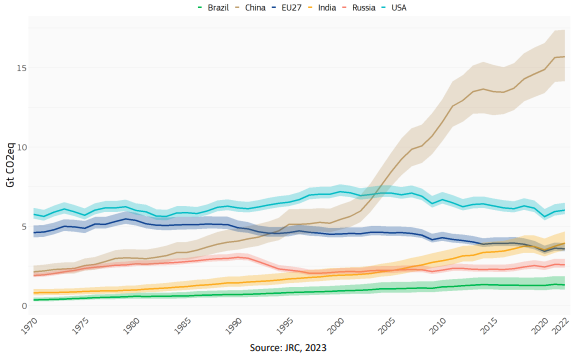
Although some countries have made the needed strides, the report showed that more action is needed globally to stem the trajectory of increasing greenhouse gas (GHG) emissions. Based on research from the European Commission’s Emissions Database for Global Atmospheric Research (EDGAR), as of 2023, G20 countries have contributed 75% of current global GHG emissions, with China, the United States, India, the European Union, and Brazil taking the top spots.
Trinidad and Tobago’s zigs & zags toward greener energy
The climate crisis has disproportionately affected small island developing states compared to larger, wealthier, and more developed nations. Trinidad and Tobago (T&T) is a comparatively minor contributor to GHG emissions, ranking 87th worldwide. However, this does not absolve us of our role in contributing to a warmer world. According to the 2023 EDGAR report, T&T is the highest greenhouse gas emitter in the Caribbean and across the Caribbean Community (CARICOM).
For years, T&T’s Prime Minister, Dr. Keith Rowley, has stated that as long as there is a market for hydrocarbons, the country will remain in the business of it. Speaking at a media briefing over two years ago at the Piarco International Airport before boarding a flight to COP26 in Glasgow, Rowley said while the world is leaning towards cleaner, more environmentally friendly energy sources, the energy transition cannot happen overnight.
The change is slowly happening, and Trinidad and Tobago is no exception. Fast-forward one and a half years, and at the groundbreaking ceremony of the country’s soon-to-be largest solar farm project, the Prime Minister reiterated, “We will continue to extract hydrocarbons available to us as long as there is an international market,” as executives from BP and Shell looked on.
Countries like the United States, the United Arab Emirates, where COP28 will be held, and Saudi Arabia are also developing large-scale solar farms and facilities while exploring more oil and gas.
Most Caribbean nations’ economies are supported by tourism, brought about by their white, sandy beaches, mountainous forests, melodic music, and cuisine unlike any other. In Trinidad and Tobago, while these facets attract tourists worldwide, hydrocarbons have been the pillar of the country’s economy for over a century. T&T is one of the largest producers of fossil fuels in the Western Hemisphere, with oil and gas permeating nearly every tenant of the country’s culture.
The problem for developing countries rich with hydrocarbons like Trinidad and Tobago, and now joined by Guyana, is that transitioning to renewable energy is expensive, and the current economies rely on the spoils from hydrocarbons for social programmes, cheap fuel, and electricity.
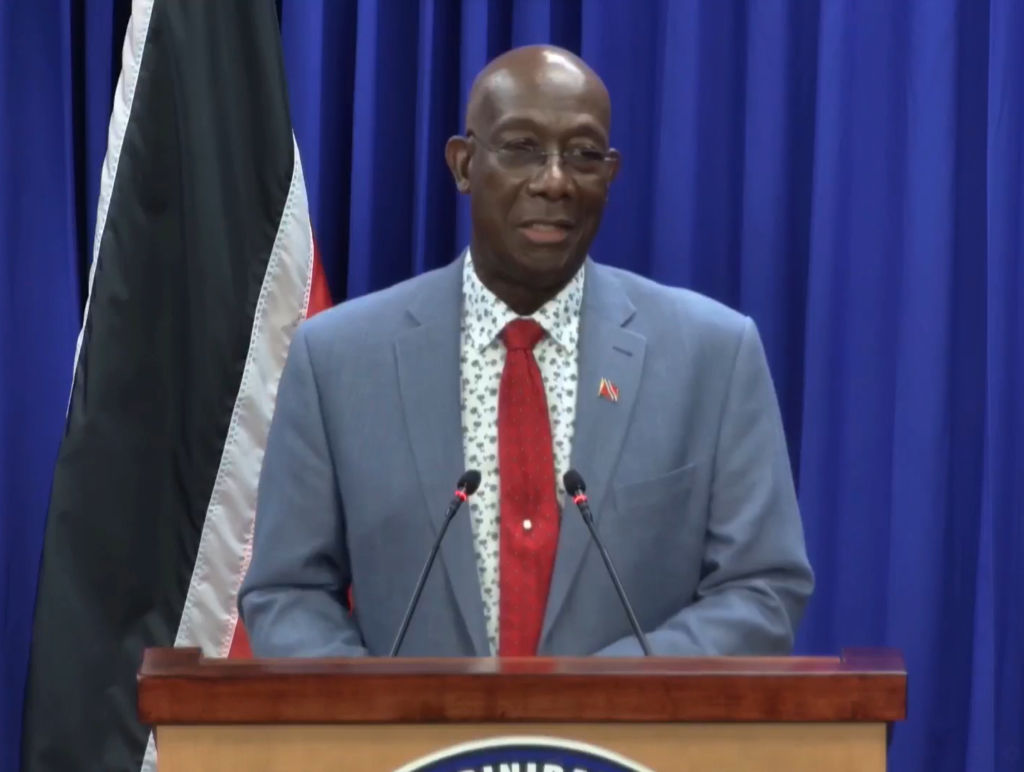
Reaffirming his commitment to generating greener energy, Rowley said in a post-Cabinet briefing on October 26th, 2023, “We are taking steps to reduce our carbon footprint by investing in sustainable energy. We have a 112-megawatt solar farm under construction but will not abandon all hydrocarbon opportunities.”
Trinidad and Tobago’s crude oil production has sharply declined in recent decades, with most of the hydrocarbon revenue originating from the extraction and export of natural gas.
T&T has become the second largest exporter of liquified natural gas in the Western Hemisphere after the United States and is one of the leading producers globally of ammonia and methanol.
As recently as one month ago, the Prime Minister announced the Government is proceeding with discussions with Venezuela for a possible 25-year exploration and production license for the Dragon field. The field holds up to 4.2 trillion cubic feet of gas and lies in Venezuelan waters near the maritime border between the two countries.
The prime minister and top hydrocarbon executives in T&T are adamant that natural gas is the country’s transition fuel. At the October 26th media briefing, Rowley said, “We support the idea, and we are one of the mouthpieces selling the idea that gas is the clean energy available now, and it certainly is the transitional energy.”
At COP28, the Ministry of Planning and Development, whose line minister, Penelope Beckles, will be leading T&T’s delegation in Dubai, will focus on fast-tracking the energy transition and slacking emissions before 2030, amongst other key issues. Renewable energy capacity needs “to reach more than 11,000 GW” by 2030, according to the United Arab Emirates’ COP28 presidency, the International Renewable Energy Agency (IRENA), and the Global Renewables Alliance in a joint report. While the push to renewable energy will significantly reduce T&T’s emissions, short-term electricity prices may increase unless subsidized by the T&T government, as is the current arrangement for natural gas-derived electricity.
The oil and gas sector has also employed tens of thousands of people in T&T and its supporting service industries so what will happen to that subset of skilled workers in the country? T&T is one of the first Caribbean countries to develop a Just Transition policy, which now lies at the Cabinet level to adopt and was submitted to the U.N. Framework Convention on Climate Change. This policy will be the guiding framework to transition out of high-carbon activities and into the green economy, seeking to avoid harm to workers and communities while maximizing the benefits of climate action.
The emissions paradox: Increased fossil fuel extraction but lower emissions?
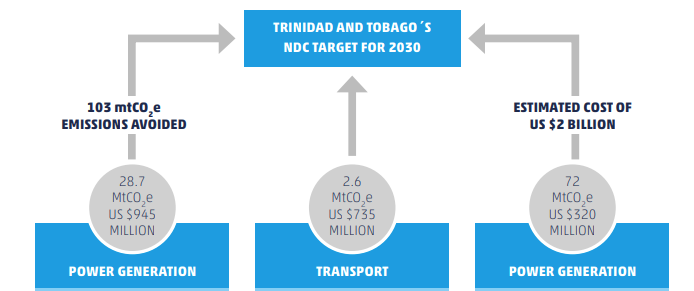
With T&T doubling down on fossil fuel exploration, production, and use, the natural conclusion would be that the country’s overall greenhouse gas emissions would increase over the last few decades. Incredibly, the latest data shows the opposite.
Trinidad and Tobago’s aim, or intentional nationally determined contributions (NDCs), is to achieve a reduction objective in overall emissions from the power generation, transportation, and industrial sectors by 15% by 2030 from business-as-usual (2013 levels). The country has also unconditionally committed to reducing public transportation emissions by 30%, compared to 2013 levels, by December 31st, 2030.
The National Gas Company of Trinidad and Tobago (NGC) has also gone a step further, according to its president Mark Loquan. Methane is a central component of natural gas and is 80 times more effective at retaining heat in the atmosphere than carbon dioxide. Loquan said, “As a gas company, we have a responsibility to say, well, let’s join the Oil and Gas Methane Partnership, which is over 80 companies worldwide. And we did that. Let’s use satellites in the sky to see it as infrared cameras on the ground to see it. And let’s reach the gold standard, which was achieved in October 2022.” This added another layer to the country’s NDCs.
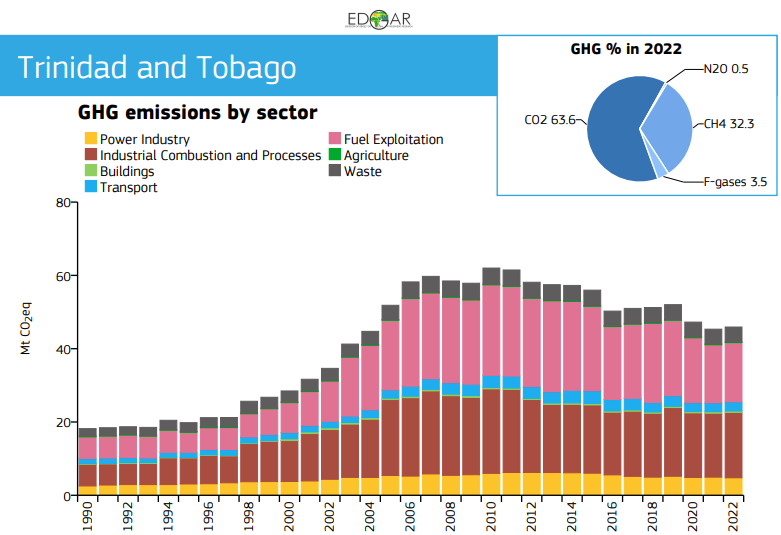
According to the latest EDGAR data, Trinidad and Tobago has had a continuing decrease in greenhouse gas emissions since 2010, with overall carbon dioxide emissions declining by 25% between 2013 and 2022. Looking at the sector-by-sector emissions decline during the same period, the industrial sector was reduced by 51%, the power generation sector decreased by 23%, and the transport sector was reduced by 19%.
However, the data only tells one part of the story. Some of these reductions may have come from improved industrial processes, onboarding micro-scale solar projects, and increased use of compressed natural gas vehicles.
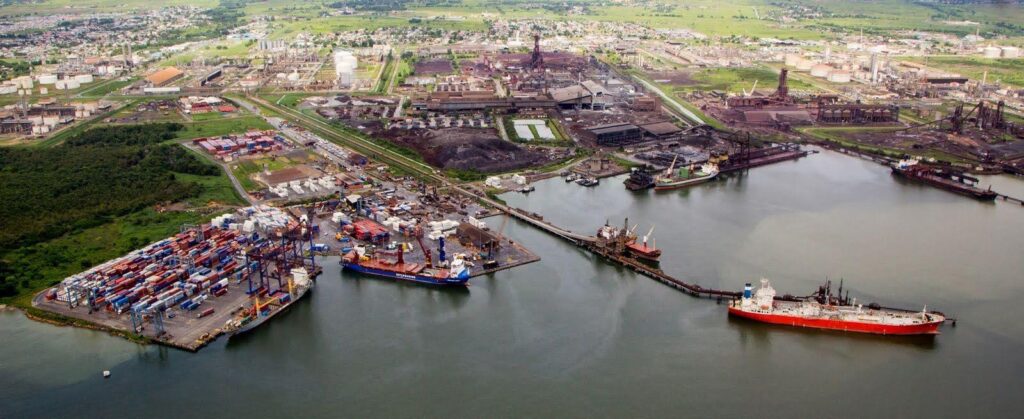
Since 2010, when emissions peaked, natural gas production has dwindled, and so too, have emissions. Trinidad and Tobago can process 4.2 billion cubic feet daily into LNG, petrochemicals, and power, but its current gas production is about 2.7 billion cubic feet daily.
A greener future
With decreasing gas production, even with some prospects of increased gas soon, some energy companies are working in Trinidad and Tobago to create a greener energy industry. A homegrown energy company, Kenesjay Green, is working to produce hydrogen in the Point Lisas petrochemical complex through a partnership with Yara Trinidad, an ammonia producer. The University of Trinidad and Tobago is leading an effort to map a “carbon-capture atlas” of depleted oil and gas fields that can be used to store carbon captured from Trinidadian petrochemical plants to help the country offset most or all of its greenhouse gas emissions.
In the power generation sector, Trinidad and Tobago is working with the European Union to implement a commercial-scale solar farm at the Piarco International Airport and install 12 solar panel packages on public buildings across the country, with ten of the 12 already installed to date. The government has also been developing a feed-in tariff policy since 2015 to allow households and commercial entities to feed renewable power into the national grid.
Within the transport sector, the Government has procured 240 electric buses to complement the current fleet of compressed natural gas and petrol buses.
As COP28 nears, the world will be taken to task in the first Global Stocktake on their nationally determined contributions. Trinidad and Tobago has made steady progress; whether intentionally or not, more has to be done to avoid a future where the world warms past the critical 1.5 degree Celsius target. At the NDC Synthesis Report Launch in New York, the United Nations Secretary-General pleaded, “Inch by inch progress will not do. It is time for a climate ambition supernova in every country, city, and sector.”
This story was published through the COP28 Climate Justice Reporting Fellowship with the support of Open Society Foundations.